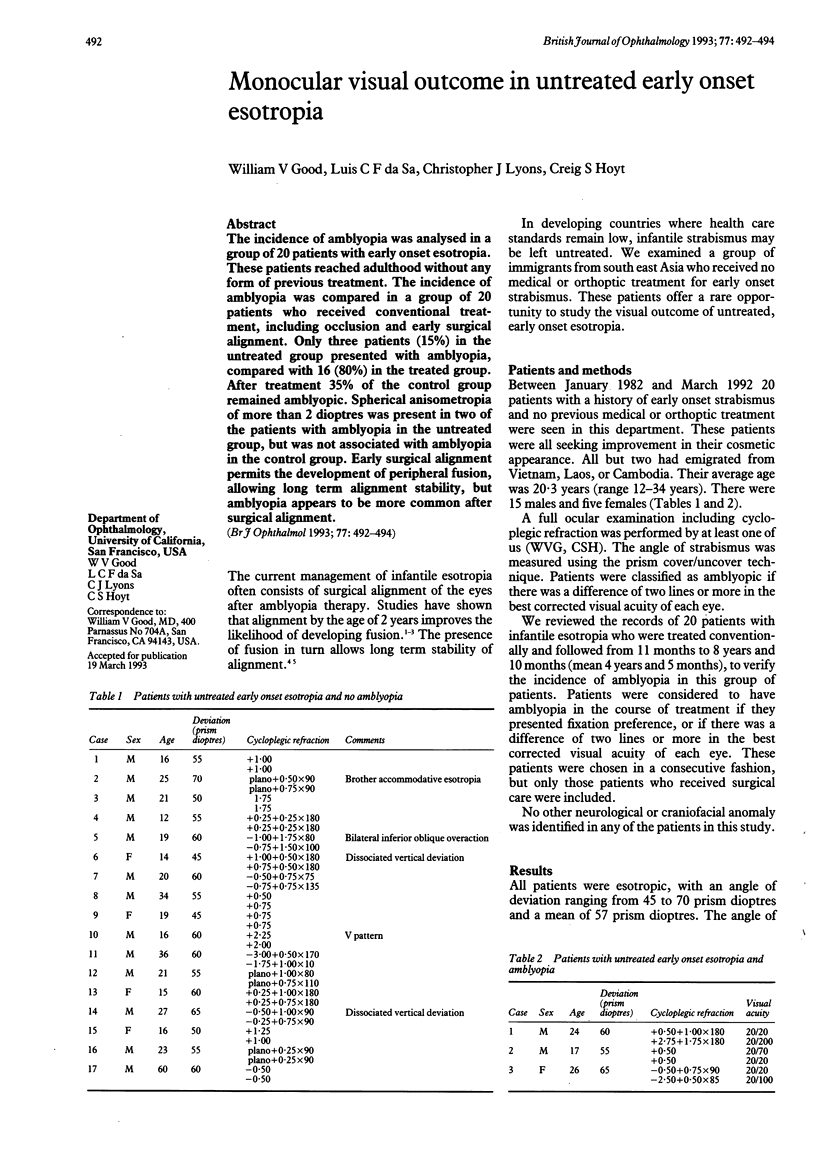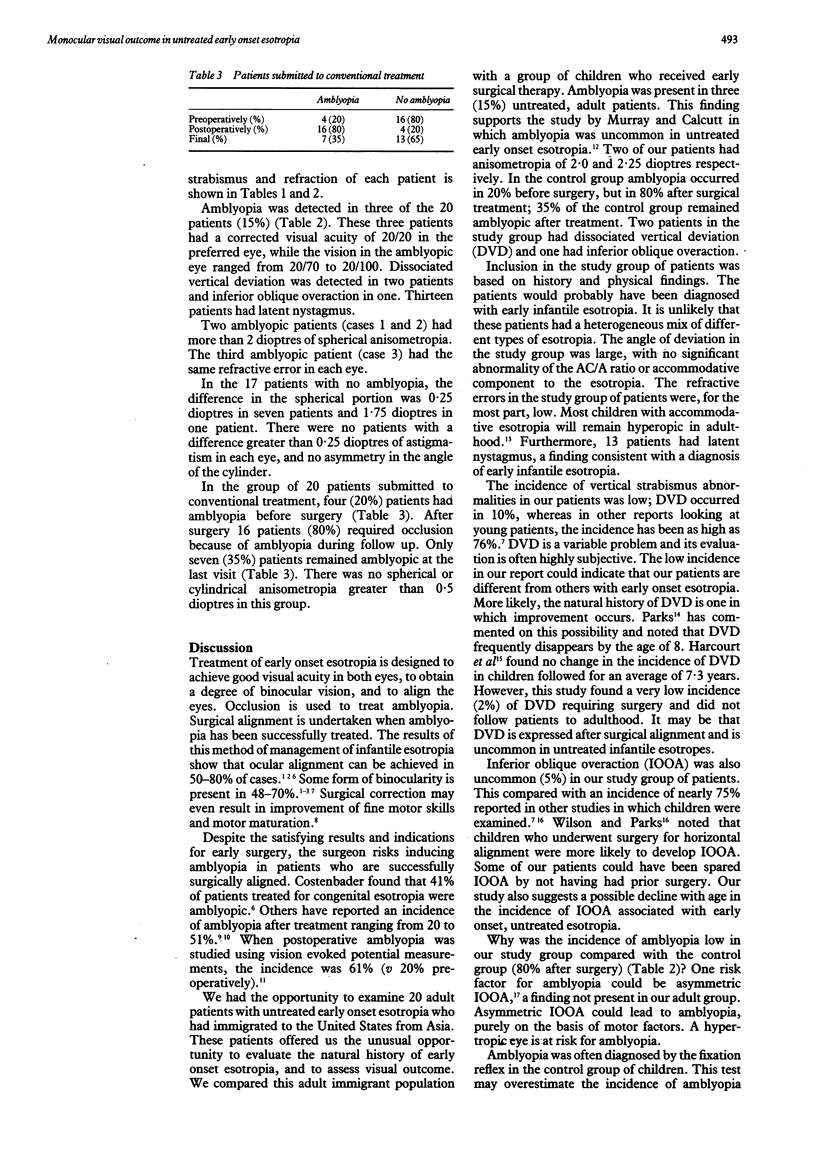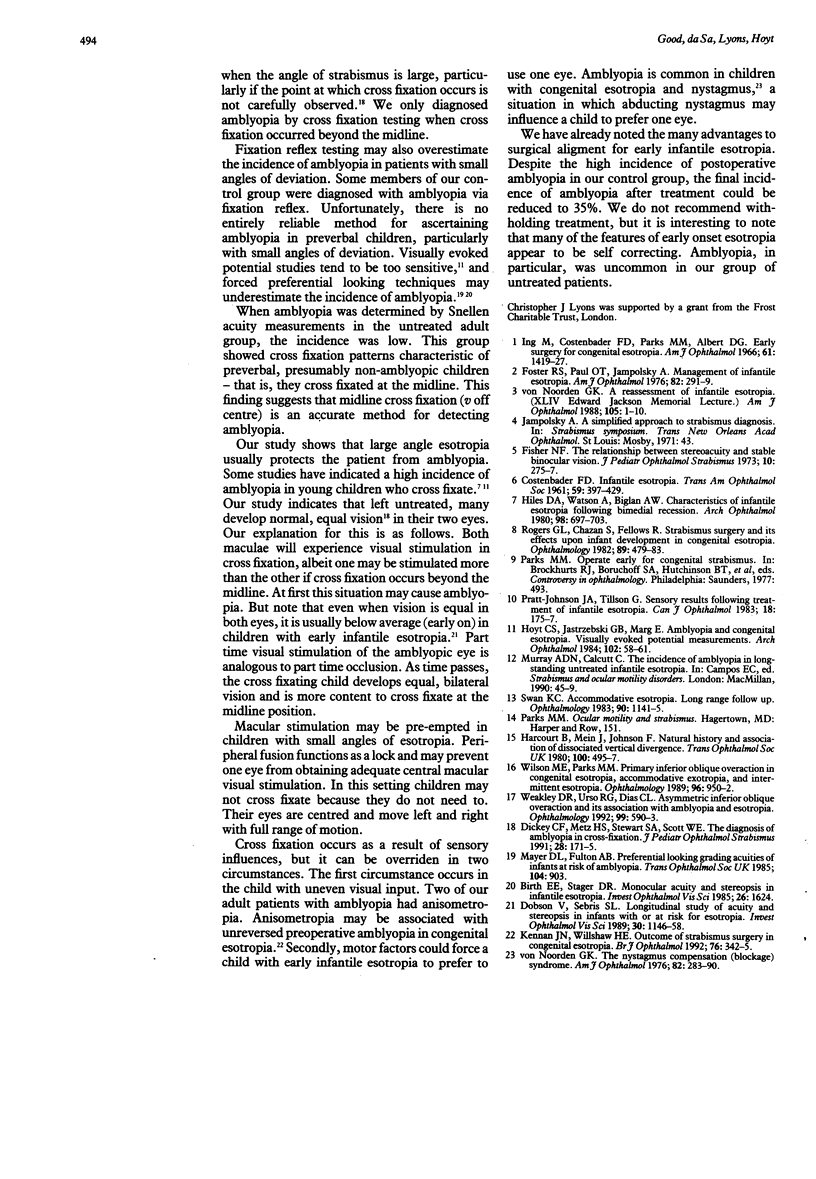Abstract
The incidence of amblyopia was analysed in a group of 20 patients with early onset esotropia. These patients reached adulthood without any form of previous treatment. The incidence of amblyopia was compared in a group of 20 patients who received conventional treatment, including occlusion and early surgical alignment. Only three patients (15%) in the untreated group presented with amblyopia, compared with 16 (80%) in the treated group. After treatment 35% of the control group remained amblyopic. Spherical anisometropia of more than 2 dioptres was present in two of the patients with amblyopia in the untreated group, but was not associated with amblyopia in the control group. Early surgical alignment permits the development of peripheral fusion, allowing long term alignment stability, but amblyopia appears to be more common after surgical alignment.
Full text
PDF


Selected References
These references are in PubMed. This may not be the complete list of references from this article.
- Birch E. E., Stager D. R. Monocular acuity and stereopsis in infantile esotropia. Invest Ophthalmol Vis Sci. 1985 Nov;26(11):1624–1630. [PubMed] [Google Scholar]
- COSTENBADER F. D. Infantile esotropia. Trans Am Ophthalmol Soc. 1961;59:397–429. [PMC free article] [PubMed] [Google Scholar]
- Dickey C. F., Metz H. S., Stewart S. A., Scott W. E. The diagnosis of amblyopia in cross-fixation. J Pediatr Ophthalmol Strabismus. 1991 May-Jun;28(3):171–175. doi: 10.3928/0191-3913-19910501-14. [DOI] [PubMed] [Google Scholar]
- Dobson V., Sebris S. L. Longitudinal study of acuity and stereopsis in infants with or at-risk for esotropia. Invest Ophthalmol Vis Sci. 1989 Jun;30(6):1146–1158. [PubMed] [Google Scholar]
- Foster R. S., Paul T. O., Jampolsky A. Mangement of infantile esotropia. Am J Ophthalmol. 1976 Aug;82(2):291–299. doi: 10.1016/0002-9394(76)90436-0. [DOI] [PubMed] [Google Scholar]
- Harcourt B., Mein J., Johnson F. Natural history and associations of dissociated vertical divergence. Trans Ophthalmol Soc U K. 1980;100(4):495–497. [PubMed] [Google Scholar]
- Hiles D. A., Watson B. A., Biglan A. W. Characteristics of infantile esotropia following early bimedial rectus recession. Arch Ophthalmol. 1980 Apr;98(4):697–703. doi: 10.1001/archopht.1980.01020030691008. [DOI] [PubMed] [Google Scholar]
- Hoyt C. S., Jastrzebski G. B., Marg E. Amblyopia and congenital esotropia. Visually evoked potential measurements. Arch Ophthalmol. 1984 Jan;102(1):58–61. doi: 10.1001/archopht.1984.01040030042031. [DOI] [PubMed] [Google Scholar]
- Ing M., Costenbader F. D., Parks M. M., Albert D. G. Early surgery for congenital esotropia. Am J Ophthalmol. 1966 Jun;61(6):1419–1427. doi: 10.1016/0002-9394(66)90480-6. [DOI] [PubMed] [Google Scholar]
- Keenan J. M., Willshaw H. E. Outcome of strabismus surgery in congenital esotropia. Br J Ophthalmol. 1992 Jun;76(6):342–345. doi: 10.1136/bjo.76.6.342. [DOI] [PMC free article] [PubMed] [Google Scholar]
- Mayer D. L., Fulton A. B. Preferential looking grating acuities of infants at risk of amblyopia. Trans Ophthalmol Soc U K. 1985;104(Pt 8):903–911. [PubMed] [Google Scholar]
- Pratt-Johnson J. A., Tillson G. Sensory results following treatment of infantile esotropia. Can J Ophthalmol. 1983 Jun;18(4):175–177. [PubMed] [Google Scholar]
- Rogers G. L., Chazan S., Fellows R., Tsou B. H. Strabismus surgery and its effect upon infant development in congenital esotropia. Ophthalmology. 1982 May;89(5):479–483. doi: 10.1016/s0161-6420(82)34766-1. [DOI] [PubMed] [Google Scholar]
- Swan K. C. Accommodative esotropia long range follow-up. Ophthalmology. 1983 Oct;90(10):1141–1145. doi: 10.1016/s0161-6420(83)34415-8. [DOI] [PubMed] [Google Scholar]
- Weakley D. R., Jr, Urso R. G., Dias C. L. Asymmetric inferior oblique overaction and its association with amblyopia in esotropia. Ophthalmology. 1992 Apr;99(4):590–593. doi: 10.1016/s0161-6420(92)31922-0. [DOI] [PubMed] [Google Scholar]
- Wilson M. E., Parks M. M. Primary inferior oblique overaction in congenital esotropia, accommodative esotropia, and intermittent exotropia. Ophthalmology. 1989 Jul;96(7):950–957. doi: 10.1016/s0161-6420(89)32774-6. [DOI] [PubMed] [Google Scholar]
- von Noorden G. K. A reassessment of infantile esotropia. XLIV Edward Jackson memorial lecture. Am J Ophthalmol. 1988 Jan 15;105(1):1–10. doi: 10.1016/0002-9394(88)90113-4. [DOI] [PubMed] [Google Scholar]
- von Noorden G. K. The nystagmus compensation (blockage) syndrome. Am J Ophthalmol. 1976 Aug;82(2):283–290. doi: 10.1016/0002-9394(76)90435-9. [DOI] [PubMed] [Google Scholar]


